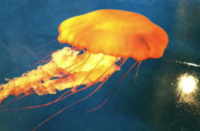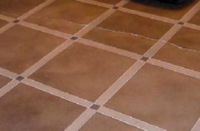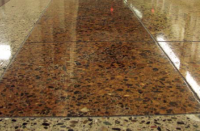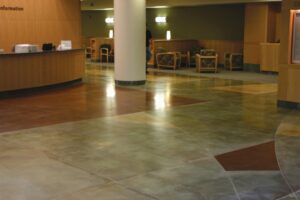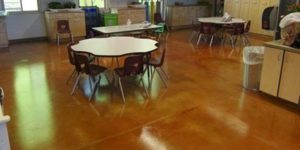Iron Giant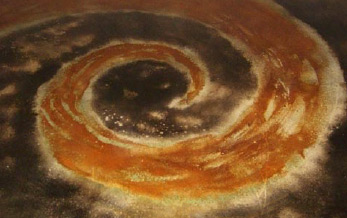
Jeroen H.F. Kaijser Bots
EuroFloors – Huntersville, N.C. www.eurofloors.us
Using iron shavings to alter the reaction of the stains, this recipe is ideal if you’re after dramatic patterns and bold swirls of color.
Ingredients:
- Savogran TSP Substitute
- Renaissance Concrete Chemical Stains: Ebony Stone and Vermont Slate
- Iron shavings (you can buy standard metal shot for shotblasting at a local machine shop or go to your local garage and ask for metal shavings)
- Ammonia solution, 5:1 water to ammonia
- For residential installations:
- Kemiko Stone Tone Sealer II water-based acrylic sealer
- ZEP Z-Tread UHS Floor Finish topcoat
- For commercial installations:
- Kemiko Sta-Crete 1600 water-extended epoxy coating
- SureCrete Dura-Kote Polyurethane Concrete Sealer
- Special equipment required: Floor buffing machine with a range of buffing pads
Directions:
- Broom the entire area clean.
- Clean the slab with TSP solution and a blue or black pad on your floor buffer. (The type of pad you use will depend on the porosity of the concrete. Don’t use an overly aggressive pad, as it can damage the concrete and expose the aggregate.) Do not use muriatic acid to clean the slab.
- Draft the design on the floor with white chalk. (Don’t use colored chalk, as it will interact with the stains.)
- Spread the iron shavings in the outline of your design. The iron is going to react with your stains, rusting very quickly and lending great color variations to the final floor. As you spread the shavings onto your design, don’t try to cover your shapes evenly. The more uneven you are, the wilder your final design will be.
- Mix the acid color for the design (for this application, the Vermont Slate), and your background color (Ebony Stone) in two separate pump sprayers at the ratios you’ve determined you want during preapplication testing.
- Spray the Vermont Slate onto your metal shavings.
- Immediately after, spray the background color around the design. You want the wet acids to flow into each other for additional effects.
- Once the acid has cured entirely, you’re ready to clean and neutralize. First, sweep the metal shavings or shot off your surface. Then, using your floor buffer with a white buffing pad, scrub the floor with your ammonia solution. Wet-vac to remove the residue. Rinse the floor with clean water.
- If you’re unhappy with your colors (the acids don’t always take the first time), you can spray another application of acid to achieve the desired result. Repeat the cleaning and neutralizing process once your second application has had time to cure.
- Seal your floor. For residential installations, install two coats of the Stone Tone sealer, followed by three coats of Floor Finish topcoat. For a more durable finish, ideal for commercial jobs, use one coat of Sta-Crete with one coat of Dura-Kote to finish it off.
